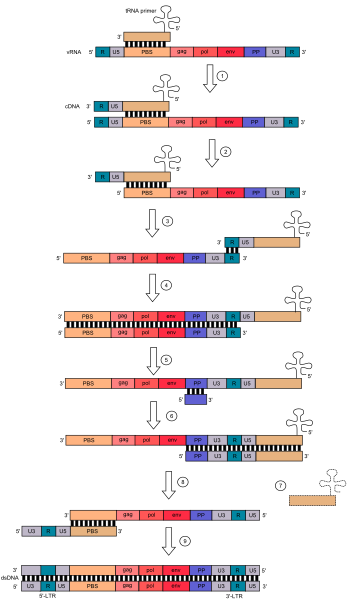Archivo: Reverse transcription

Descripción: Mechanism of reverse transcription in class VI virus ssRNA-RT, human immunodeficiency virus (HIV). Key: U3 - promoter region, U5 - recognition site for viral integrase; PBS - primer binding site; PP - polypurine section (polypurine tract); gag, pol, env - see HIV genome organisation). Colors mark complementary sequences. This diagram isn't drawn to scale. Reverse transcription occurs in the cytoplasm of host cell. In this process, viral ssRNA is transcribed by the viral reverse transcriptase (RT) into double stranded DNA. Reverse transcription takes place in 5'→3' direction. tRNA ("cloverleaf") hybridizes to PBS and provides -OH group for initiation of reverse transcription. 1) Strong stop complementary DNA (cDNA) is formed. 2) Template in RNA:DNA hybrid is degraded by RNase H domain of reverse transcriptase 3) DNA:tRNA is transferred to the 3'-end of the template (synthesis "jumps"). 4) First strand synthesis takes place. 5) The rest of viral ssRNA is degraded by RNase H, except for PP site. 6) Synthesis of second strand of ssDNA is initiated from the 3'-end of the template. tRNA is necessary to synthesis of complementary PBS 7) tRNA is degraded 8) After another "jump", PBS from the second strand hybridizes with the complementary PBS on the first strand. 9) Synthesis of both strands is completed by the DNAP function of reverse transcriptase. Both dsDNA ends have U3-R-U5 sequences, so called long terminal repeat sequences (3'LTR and 5'LTR, respectively). LTRs mediate integration of the retroviral DNA into another region of the host genome. Sources: Alan Cann: Principles of molecular virology. Amsterdam: Elsevier Academic Press, 2005, p. 93 ISBN 0-12-088787-8.; en:Reverse transcription entry in Wikipedia.
Título: Reverse transcription
Créditos: Trabajo propio
Autor(a): Este gráfico vectorial, sin especificar según el W3C, fue creado con Inkscape.
Términos de Uso: Creative Commons Attribution 3.0
Licencia: CC BY 3.0
Enlace de Licencia: https://creativecommons.org/licenses/by/3.0
¿Se exige la atribución?: Sí
Usos del archivo
La siguiente página enlaza a este archivo:

